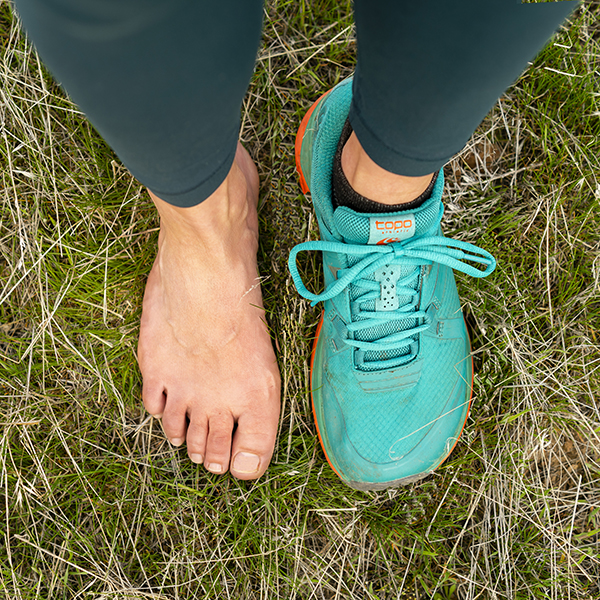Did you know that most common foot issues have been linked to modern footwear, which cause the progressive deformation of the foot starting at the age of 3? As the body grows and adapts to new activities, the deformities in a person’s feet start to inhibit the body’s natural balance and kinetic chain, resulting in injury when the rest of the body can no longer compensate.
We teamed up with Dr. Ray McClanahan, podiatrist and founder/inventor of Correct Toes, to compile a short list of ways to reverse some of this damage and other tips for maintaining happy feet (especially for the runners and outdoor enthusiasts among us!). Dr. McClanahan is a natural foot care expert and elite distance runner that has partnered with many prominent experts across multiple disciplines to help people restore their natural and functional body movement, starting from the toes.
1. Do toe stretches: It might sound weird, but your toes need mobility maintenance too.This toe extensor stretch is beneficial for those who have worn conventional footwear over the course of their lives. Got bunions? Check out this bunion stretch and consider switching to running shoes with a toe box that is widest at the tips/ends of the toes, since conventional running shoes typically run narrow/pointy and can exacerbate bunion issues.

2. Be selective about your footwear: Active individuals benefit the most from footwear that is:
- Flexible
- Widest at the tips/ends of the toes
- Low drop (zero if possible)
- Well fitted in the midfoot and heel
- Doesn’t have a rigid toe springJust enough cushioning to protect feet from sharp objects and surface irregularities
Overly cushioned shoes can mask the terrain underfoot, making your feet less responsive. A wide toe box will allow for independent toe movement which aids in balance and proper toe off in the gait cycle. See here for a curated list of Correct Toes Approved shoes.

3. Transition slowly to lower drop: Drop refers to the angle from your heel to toes on a shoe platform. The goal should be to transition to a shoe that is anywhere from 0-5 mm in drop, but do it slowly; this program can help ease the transition. This will progressively stretch out the posterior calf muscles and hamstring muscles, making stretching those muscle groups unnecessary for active individuals.
4. Prevent Athlete’s Foot: This condition is encouraged by spending a lot of time in shoes, which provide the dark, heated and damp environment conducive to growing fungal and bacterial organism. What helps is keeping things dry:
- Go barefoot often, which also strengthens and thickens the skin on the bottoms of our feet, making them less permeable to foreign objects and infectious organisms.
- Wear moisture-wicking fiber socks
- If your shoes are wet from sweat/environmental factors, air dry completely before using again (you can also use a plug-in shoe dryer, but never put your shoes in the clothes dryer!)
- Emery boards and pumice stones are good tools for managing thick toenails and calluses.

5. Pay attention to wear patterns: Look out for places in the upper where the mesh is fraying/wearing out (especially around the big and pinky toe areas); both are signs that the shoe may be too narrow for you. Also try taking the a sock liner test: take out the footbed/sock liner and stand on it in order to observe how the shoe relates to the shape of your own foot.
All that being said, be sure to promptly see a podiatrist if you need surgery, have a broken bone, torn tendon/ligament, an infection, or even if you are experiencing severe foot/ankle/lower leg pain.
However, understand that podiatrists are providers of allopathic medical care, which means that treatment to make symptoms go away is the focus. It is worthwhile to also consider other types of medical foot/ankle/lower leg care that seeks to evaluate the root cause of the injury/ailment, in addition to providing symptom reducing treatments. These providers define themselves as functional, holistic, natural, alternative, complementary, etc. and include chiropractors, naturopaths, osteopaths, acupuncturists, reflexologists, medical doctors, podiatrists, physical therapists, personal trainers, etc. If you are looking for natural foot care, research the podiatrist you are considering consulting with since podiatrists are traditionally not trained in natural foot care.
Happy Foot Health Awareness Month!
For more tips from Dr. McClanahan, keep an eye on this blog where he will be diving into other common foot ailments common among runners and outdoor enthusiasts, like blisters, callouses, etc. Also tune into Dr. McClanahan’s Instagram Live event with Tony Post later this month – more details to come.
About Dr. Ray McClanahan

In addition to inventing the silicon spacers he branded as Correct Toes, Dr. Ray McClanahan owns a podiatry practice, called Northwest Foot & Ankle, in Portland, Oregon. During his 18-years as a podiatrist, Dr. McClanahan learned that most foot problems can be corrected by restoring natural foot function. That is why his practice strives to provide quality natural foot health services (with an emphasis on sports medicine), preventative and conservative options, as well as education on proper footwear.
Dr. McClanahan is an active runner and athlete. In 1999, he finished 14th in the U.S. National Men’s Cross-Country Championships and had a near Olympic Trials qualifying 5,000 meter mark of 13:56 in 2000. He then qualified for the World Duathlon Championships in 2001.
I wish Topo would follow Dr McClanahan’s advise on reducing toe-spring.
Good information here. I knew generally about the evils of wearing shoes that are too narrow and that’s why I’m a Topo fan. But, even though I have developed a bunion, post tibial tendinosis, and more recently metatarsalgia all in the same foot, no medical professional has ever recommended the toe and bunion stretching exercises to me. Thanks!
I work at REI and absolutely love my Topo footwear.
I hope to get the new Trailventure Hiking boot.
My feet and toes thank you.